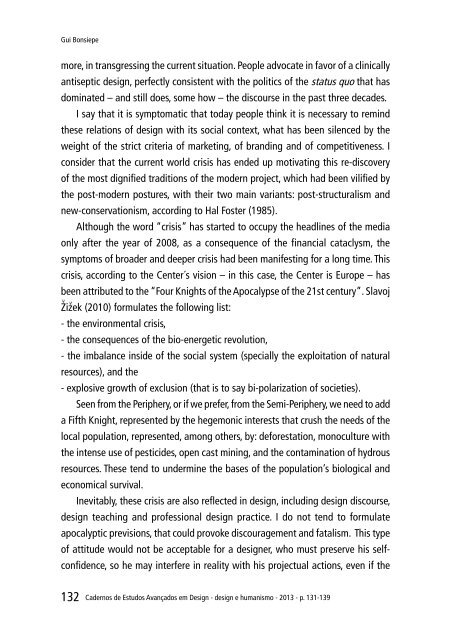o_19po8js951tvs1r0t1r8s4bb1vpla.pdf
You also want an ePaper? Increase the reach of your titles
YUMPU automatically turns print PDFs into web optimized ePapers that Google loves.
Gui Bonsiepe<br />
more, in transgressing the current situation. People advocate in favor of a clinically<br />
antiseptic design, perfectly consistent with the politics of the status quo that has<br />
dominated – and still does, some how – the discourse in the past three decades.<br />
I say that it is symptomatic that today people think it is necessary to remind<br />
these relations of design with its social context, what has been silenced by the<br />
weight of the strict criteria of marketing, of branding and of competitiveness. I<br />
consider that the current world crisis has ended up motivating this re-discovery<br />
of the most dignified traditions of the modern project, which had been vilified by<br />
the post-modern postures, with their two main variants: post-structuralism and<br />
new-conservationism, according to Hal Foster (1985).<br />
Although the word “crisis” has started to occupy the headlines of the media<br />
only after the year of 2008, as a consequence of the financial cataclysm, the<br />
symptoms of broader and deeper crisis had been manifesting for a long time. This<br />
crisis, according to the Center´s vision – in this case, the Center is Europe – has<br />
been attributed to the “Four Knights of the Apocalypse of the 21st century”. Slavoj<br />
Zizek (2010) formulates the following list:<br />
- the environmental crisis,<br />
- the consequences of the bio-energetic revolution,<br />
- the imbalance inside of the social system (specially the exploitation of natural<br />
resources), and the<br />
- explosive growth of exclusion (that is to say bi-polarization of societies).<br />
Seen from the Periphery, or if we prefer, from the Semi-Periphery, we need to add<br />
a Fifth Knight, represented by the hegemonic interests that crush the needs of the<br />
local population, represented, among others, by: deforestation, monoculture with<br />
the intense use of pesticides, open cast mining, and the contamination of hydrous<br />
resources. These tend to undermine the bases of the population’s biological and<br />
economical survival.<br />
Inevitably, these crisis are also reflected in design, including design discourse,<br />
design teaching and professional design practice. I do not tend to formulate<br />
apocalyptic previsions, that could provoke discouragement and fatalism. This type<br />
of attitude would not be acceptable for a designer, who must preserve his selfconfidence,<br />
so he may interfere in reality with his projectual actions, even if the<br />
132<br />
Cadernos de Estudos Avançados em Design - design e humanismo - 2013 - p. 131-139



